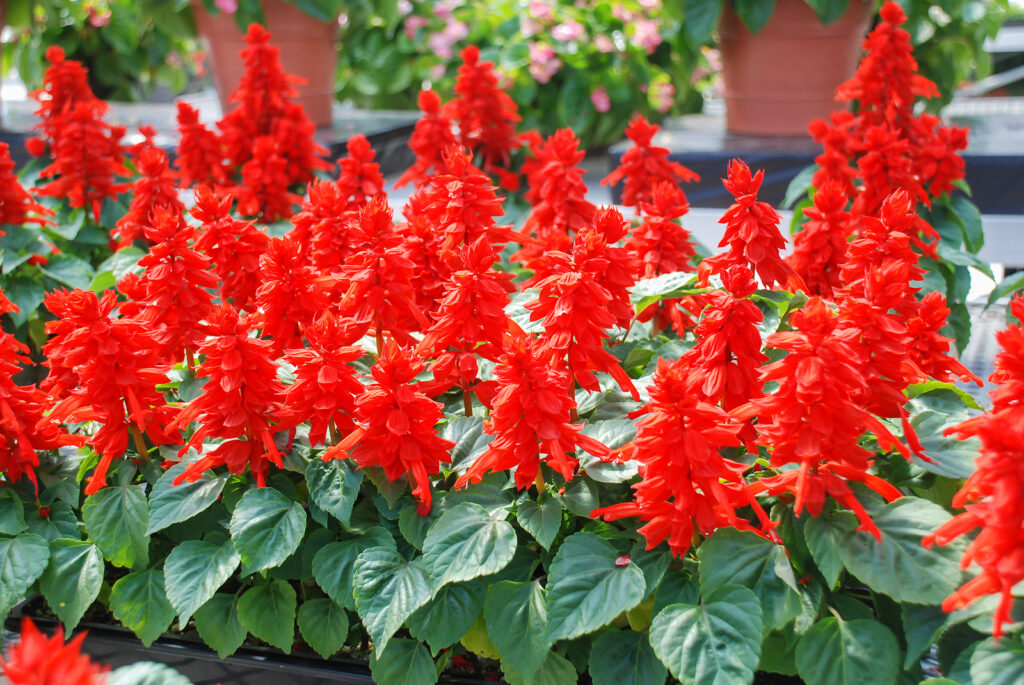Annual red salvia, Salvia splendens, produces spikes of tubular bright scarlet, pink, or white flowers through summer. Annual red salvia is also called scarlet sage.
Annual red salvia is an upright tender perennial, grown as an annual, with spear-shaped dark green leaves.
Salvia likes full sun or partial shade and humus-rich, well-drained soil. Sage can tolerate dry soils but do best when evenly watered.
Flower Garden Success Products at Amazon:
- Wildflower Seed Mix Attracts Hummingbirds and Butterflies
- Eden Brothers All Perennial Seed Mix
- 10 pcs Stainless Steel Garden Hand Tool Set
- Gorilla Cart 4 Cu. Ft, 300-pound Capacity
- Neem Bliss 100-% Cold Pressed Neem Oil
- Safer Brand Insect Killing Soap
Get to know annual red salvia
- Plant type: Tender perennial commonly grown as an annual
- Growing Zones and range: Zones 3-11
- Hardiness: Tender
- Height and width: 6 to 36 inches (15-91cm) tall; 4-24 inches (10-61cm) wide
- Flowers: Bright red, purple, neon rose, and salmon
- Bloom time: Summer to frost
- Uses: Bedding annual, containers
- Common name: Annual red salvia, scarlet sage
- Botanical name: Salvia splendens
- Family: Lamiaceae
Where to plant annual red salvia
- Grow annual red salvia in full sun.
- Plant annual red salvia in average, well-drained soil.

When to plant annual red salvia
- Set annual red salvia in the garden in spring after all danger of frost has passed.
- Start seeds indoors 8 weeks before the last frost.
- Sow seeds outdoors after all danger of frost has passed.
- Thin or transplant seedlings when they are 4 inches (10cm) high.
- Set indoor-grown plants outdoors after the last frost.
Planting and spacing annual red salvia
- Indoors sow seed in flats or pots; cover seeds with 1/8 inch soil. Grow seeds indoors
- Water and keep seed warm 65° to 75°F (18°-24°C); seeds germinate in about 14 days, sometimes less. Grow in bright sunlight or a few inches below fluorescent light.
- Sow seed outdoors in drills about 2 inches (5cm) deep; plant seeds 2 inches (5cm) and cover with 1/8 inches of soil.
- Thin or transplant seedlings when they are about 4 inches (10cm) tall.
- Space salvias in the garden 6 to 18 inches (15-45cm) apart depending on the variety.

How to water and feed annual red salvia
- Annual red salvia needs even soil moisture.
- Fertilize annual red salvia every 4 weeks with an all-purpose fertilizer or work a slow-release fertilizer into the soil at planting time.
Annual red salvia care
- Mulch around red salvia to conserve soil moisture.
- Pinch off spent flowers to promote new blooms.
- Promote branching by pinching away growth tips at the end of branches.
- Annual red salvia is prone to leaf spot, rust, aphids, and leafhoppers
Annual red salvia varieties to grow
- Salvia splendens grow well in full sun or light shade and need ample water.
- ‘Hotline’ grows in Zones 2-9; it is heat and drought-tolerant.
- ‘Bonfire’ blooms with scarlet flowers from midsummer to first fall frost.
Red salvia frequently asked questions
Q: What growing conditions do salvia like?
A: Salvia like full sun or partial shade and humus-rich, well-drained soil. Salvias tolerate dry soils but do best when evenly watered. Salvias are sensitive to fertilizer burn, so need them often but lightly throughout the summer.
Q: There is red salvia and blue salvia. How are they different?
A: The red salvia, S. splendens, also has forms in blue, purple, white, and salmon. The blue salvia is S. farinacea. It grows as a perennial in mild climates; in cooler regions, it is grown as an annual.
Q: How do you start red salvia seeds?
A: Red salvias. Salvia splendens, must be started indoors 8 to 10 weeks before the last frost. Blue salvia, S. farinacea, must be started even early, 12 weeks before planting outdoors. Seeds of red-flowered varieties need light to germinate; the others do not. Salvia should be planted in the garden before it is in bloom for best results. Don’t start seeds or set out plants too early.
Also of interest:
How to Grow Annual Blue Salvia
Related Articles:
- 20 Perennials That Bloom for 6 to 8 Weeks
- Shrubs with Showy Flowers Season-by-Season
- Trees in Garden Design
- Growing Annuals for Summer Bloom
- Trees—click here for more articles
- Shrubs—click here for more articles
- Perennials—click here to see more
- Annuals—click here to see more



